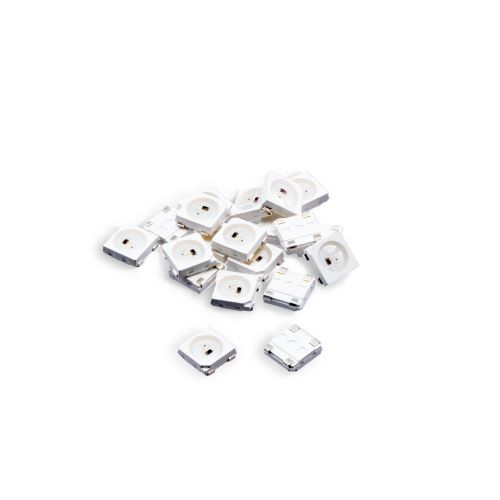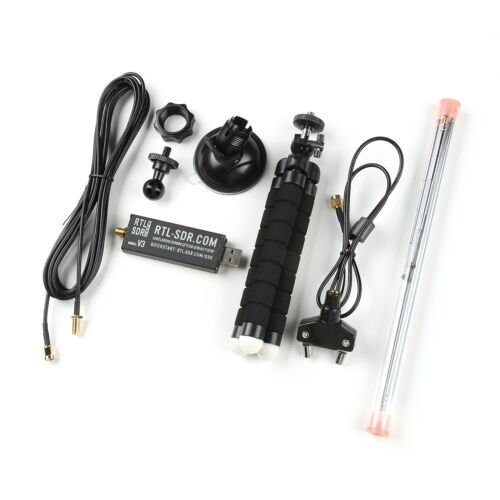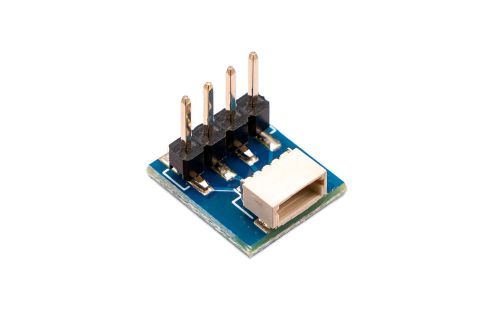These step-down (Buck) converters are a perfect way to decrease a DC voltage to something suitable for your project's needs.
- Mini DC/DC Step-Down (Buck) Converter - 5V @ 1A output - TSR12450SKU: ADA1065 Brand: AdafruitYour power supply problems just got SOLVED! These DC/DC converter step-down switching regulators are drop-in replacements for inefficient 78xx linear regulators...
- Pololu 12V, 15A Step-Down Voltage Regulator D24V150F12SKU: POLOLU-2885 Brand: PololuThis synchronous switching step-down (or buck) regulator takes an input voltage of up to 40 V and efficiently reduces it to 12 V with an available output current of around 15 A. Typical efficiencies of 80% to 95% along with its high current capabilities make this regulator well suited for powering large loads. The regulator features reverse voltage protection and a power-good output that indicates when the regulator cannot adequately maintain the output voltage.
- Pololu 6V, 15A Step-Down Voltage Regulator D24V150F6SKU: POLOLU-2882 Brand: PololuThis synchronous switching step-down (or buck) regulator takes an input voltage of up to 40 V and efficiently reduces it to 6 V with an available output current of around 15 A. Typical efficiencies of 80% to 95% along with its high current capabilities make this regulator well suited for powering large loads. The regulator features reverse voltage protection and a power-good output that indicates when the regulator cannot adequately maintain the output voltage.
- Pololu 1.8V, 500mA Step-Down Voltage Regulator D24V5F1SKU: POLOLU-2840 Brand: PololuThe compact (0.4″ × 0.5″) D24V5F1 synchronous buck voltage regulator takes input voltages between 3 V and 36 V and efficiently reduces them to 1.8 V while allowing for a maximum output current of 500 mA. This regulator offers typical efficiencies between 75% and 90%. The pins have a 0.1″ spacing, making this board compatible with standard solderless breadboards and perfboards.
- Pololu 9V, 500mA Step-Down Voltage Regulator D24V5F9SKU: POLOLU-2845 Brand: PololuThe compact (0.4″ × 0.5″) D24V5F9 synchronous buck voltage regulator takes an input voltage of up to 36 V and efficiently reduces it to 9 V while allowing for a maximum output current of 500 mA. This regulator offers typical efficiencies between 85% and 93% and has a very low dropout, so it can be used with input voltages as low as a few hundred millivolts above 9 V. The pins have a 0.1″ spacing, making this board compatible with standard solderless breadboards and perfboards.
- Pololu 9V, 15A Step-Down Voltage Regulator D24V150F9SKU: POLOLU-2884 Brand: PololuThis synchronous switching step-down (or buck) regulator takes an input voltage of up to 40 V and efficiently reduces it to 9 V with an available output current of around 15 A. Typical efficiencies of 80% to 95% along with its high current capabilities make this regulator well suited for powering large loads. The regulator features reverse voltage protection and a power-good output that indicates when the regulator cannot adequately maintain the output voltage.
- Pololu 9V, 600mA Step-Down Voltage Regulator D24V6F9SKU: POLOLU-2108 Brand: PololuThe compact (0.4″ × 0.5″) D24V6F9 switching step-down (or buck) voltage regulator takes an input voltage between 11.5 V and 42 V and efficiently reduces it to 9 V while allowing for a maximum output current of 600 mA. The pins have a 0.1″ spacing, making this board compatible with standard solderless breadboards and perfboards.
- SparkFun BabyBuck Regulator Breakout - 5V (AP63357)SKU: COM-21256 Brand: SparkfunThe SparkFun BabyBuck Regulator Breakout - 5V features the AP63357, a 3.5A synchronous buck converter with a wide input voltage range of 3.8V to 32V...
- SparkFun Buck Regulator Breakout - 5V (AP63357)SKU: COM-21255 Brand: SparkfunThe SparkFun Buck Regulator Breakout - 5V features the AP63357, a 3.5A synchronous buck converter with a wide input voltage range of 3.8V to 32V...$16.15 AUD, inc GSTAs low as $14.70 AUD, inc GST
Out of Stock
Sign up to get notified when it's available to order.
- 60W Adjustable DC-DC Buck Converter ModuleSKU: DFR1025 Brand: DFRobotThis 60W DC-DC Buck Converter features adjustable 0.6V-5.1V output voltage and up to 18A output current. ...
- SparkFun Buck Regulator Breakout - 3.3V (AP3429A)SKU: COM-21337 Brand: SparkfunThe SparkFun 3.3V Buck Regulator Breakout features the AP3429A from Diodes Inc., a 2A step-down DC-DC converter with an input voltage range of 2.7V to 5.5V...
- SparkFun Buck Regulator Breakout - 1.8V (AP3429A)SKU: COM-21338 Brand: SparkfunThe SparkFun 1.8V Buck Regulator Breakout features the AP3429A from Diodes Inc., a 2A step-down DC-DC converter with an input voltage range of 2.7V to 5.5V...
- 2-way Fast Charge Buck Module (Compatible with Raspberry Pi 4B & Jetson Nano)SKU: DFR0849 Brand: DFRobotThis 2 USB buck fast-charging module integrates the common 5V charging recognition function, which is compatible with 99% of the mobile phones on the market. Compared...
- 15V, 2.7A Step-Down Voltage Regulator D30V30F15SKU: POLOLU-4897 Brand: PololuThis small synchronous switching step-down (or buck) regulator takes an input voltage of up to 45 V and efficiently reduces it to 15 V. The board measures...
- 12V, 2.8A Step-Down Voltage Regulator D30V30F12SKU: POLOLU-4896 Brand: PololuThis small synchronous switching step-down (or buck) regulator takes an input voltage of up to 45 V and efficiently reduces it to 12 V. The board measures...
- 9V, 2.9A Step-Down Voltage Regulator D30V30F9SKU: POLOLU-4895 Brand: PololuThis small synchronous switching step-down (or buck) regulator takes an input voltage of up to 45 V and efficiently reduces it to 9 V. The board measures...
- 7.5V, 3A Step-Down Voltage Regulator D30V30F7SKU: POLOLU-4894 Brand: PololuThis small synchronous switching step-down (or buck) regulator takes an input voltage of up to 45 V and efficiently reduces it to 7.5 V. The board...
- 6V, 3.3A Step-Down Voltage Regulator D30V30F6SKU: POLOLU-4893 Brand: PololuThis small synchronous switching step-down (or buck) regulator takes an input voltage of up to 45 V and efficiently reduces it to 6 V. The board measures...
- 5V, 3.4A Step-Down Voltage Regulator D30V30F5SKU: POLOLU-4892 Brand: PololuThis small synchronous switching step-down (or buck) regulator takes an input voltage of up to 45 V and efficiently reduces it to 5 V. The board measures...
- 3.3V, 3.7A Step-Down Voltage Regulator D30V30F3SKU: POLOLU-4891 Brand: PololuThis small synchronous switching step-down (or buck) regulator takes an input voltage of up to 45 V and efficiently reduces it to 3.3 V. The board...
- Adafruit DC Power BFF Add-On for QT PySKU: ADA5882 Brand: AdafruitWe were recently working on a project where we really wanted to power a QT Py ESP32 from 12V - but the only power input on the board is basically USB 5V...
- 4.2-15V, 3.3A Fine-Adjust Step-Down Voltage Regulator D30V33MASSKU: POLOLU-4855 Brand: Pololu1 Typical continuous output current at 30 V in and 9 V out. Actual achievable continuous output current is a function of input and output voltages and is...
- 4.2-15V, 3.3A Fine-Adjust Step-Down Voltage Regulator w/ Adjustable Low-Voltage Cutoff D30V33MASCMASKU: POLOLU-4854 Brand: Pololu1 Typical continuous output current at 30 V in and 9 V out. Actual achievable continuous output current is a function of input and output voltages and is...
- 4.2-15V, 3A Fine-Adjust Step-Down Voltage Regulator D30V30MASSKU: POLOLU-4875 Brand: Pololu1 Typical continuous output current at 30 V in and 9 V out. Actual achievable continuous output current is a function of input and output voltages and is...
- 4.2-15V, 3A Fine-Adjust Step-Down Voltage Regulator w/ Adjustable Low-Voltage Cutoff D30V30MASCMASKU: POLOLU-4874 Brand: Pololu1 Typical continuous output current at 30 V in and 9 V out. Actual achievable continuous output current is a function of input and output voltages and is...
Featured Products
View AllMakers love reviews as much as you do, please follow this link to review the products you have purchased.































